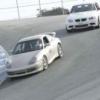Hard to say for sure, but here are some things to consider.
In my experience, it is usually the fluid. Either too old or air or moisture. I have a motive bleeder, but prefer to bleed the old fashioned way - two people, one building and then holding pressure on the pedal, and one cracking open the bleeder screws. Be sure you are bleeding from both screws on all calipers, starting with the screw farthest from the reservoir, then next farthest away, etc. And be sure you remember to bleed both screws on each caliper - i forgot one bleeder screw once. Super Blue should work for you. A lot of guys use the Motul or Castrol expensive stuff. I'm sure it is good, but as long as I keep my fluid new and properly bled, the Blue has not presented a problem for me. I bleed before every event.
Be sure you still have at least the stock air scoops to direct some cooling air to the brakes. If those are missing, there is not much else to provide cooling. The GT3 brake scoops would be an inexpensive upgrade.
I used to strictly use pagid pads, but now race in series that offers Hawk pads as a contingency, so I switched to those. I use DTC-70s and do not have experience with the other compounds. I do a lot of instructing and I've found with novices the fluid presents as a problem well before the pads. The pads become a problem only after a driver has several track days under his belt and is consistently exceeding the heat limits of the street pads. You can use a pyrometer or the color changing tapes to get an idea of how much heat you are building. If you are pretty experienced, you are probably fading the pads. The 996 in stock configuration is pretty heavy and produces a lot of heat.
Now unfortunately, "hybrid" pads are a compromise. On the track, you might be hitting 700 - 900 - 1000 degrees. Street pads, and street performance pads, are unlikely to be able to handle that heat. If you look at the compounds of the various pads available - pagid, hawk, others - they will publish the heat range in which the pad is effective. True track or race pads don't work well at lower temps. They have to have some heat in them to work well. So on the interstate driving to a track event, they can cool down and in a sudden braking moment, they may not bite initially. A lot of guys change pads when they get to the track and change back for the drive home.
On the ABS, I am frankly unsure of the answer. I think the amount of fluid is really small. And you would only be pressurizing that fluid if you get into the ABS. I have found the ABS in my 986S race car to be a bit of a PITA. It doesn't like trail braking under G load and you can feel it in the pedal being confused. I recently started using the Durametric tool to "activate" the ABS when I bleed. You will see some posts from some people about this - when you activate, you would think fluid would come out or you would hear the pump. I don't get any of that. But, it seems that the car feels better when I get into the ABS, but that might be all imagined.
Finally, and I am unsure of this, but it makes sense I suppose - a respected race shop told me once there are two reasons for braided stainless steel brake lines - first is to protect the lines from debris; second to reduce the expansion of the rubber line under pressure. I don't know about either, but do use braided lines.
Geez I'm long winded :) Here is a summary of recommendations.
* bleed properly before every event
* use a real race pad on track that can handle your heat if you are experienced driver
* use GT3 brake scoops
* use braided lines
* and if all else fails and you can determine the brakes are fading when the ABS kicks in, bleed the ABS
BTW - I do occasionally track my daily driver - my 996 C4S. I change the fluid and use DTC 70s all around. No braided lines, no ABS bleed, street tires (which means less braking) no extra cooling - and have had no fade.







